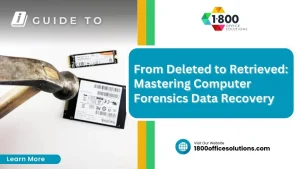Comprehensive IoT Implementation Guide for Businesses
Is your business struggling to integrate Internet of Things (IoT) solutions effectively? With 80% of companies facing challenges during IoT implementation, understanding the right steps can make a significant difference. This guide outlines essential IoT implementation steps, addresses common challenges, and highlights best practices for success. By engaging with this content, businesses will learn how to streamline operations, enhance efficiency, and better utilize IoT technology such as wireless routers for air conditioning and document management systems. Ultimately, this guide aims to ease the implementation process and fuel successful outcomes for your organization.
IoT Implementation Steps

Businesses looking to implement IoT solutions should begin by identifying their specific objectives and use cases, particularly in areas such as optimizing supply chain and manufacturing processes. Selecting the required components and prototyping the IoT solution follows, providing a foundation for effective software development. Integration with other advanced technologies and applying robust security measures ensures a comprehensive approach to IoT development, enhancing system accessibility and effectiveness.
Identify IoT Objectives and Use Cases for Your Business
Identifying IoT objectives and use cases is crucial for businesses aiming to improve operations and enhance customer experiences. Firms should evaluate how IoT can contribute to specific goals, whether through creating a smart city infrastructure that optimizes resource use or implementing telemetry systems that monitor and analyze equipment performance in real-time. Understanding these applications allows organizations to craft tailored strategies that leverage electronic engineering principles for maximum impact.
Moreover, integrating access control solutions into various processes can significantly enhance security and streamline operations. For instance, businesses could utilize IoT sensors to manage entrances and monitor facility access, thereby ensuring a safer environment. By focusing on these integral elements, enterprises can develop a robust framework that aligns their IoT implementation with their overarching business objectives, driving efficiency and innovation forward.
Select Required IoT Components for Your Use Case
Selecting the appropriate IoT components for a business’s specific use case is essential for fostering innovation and functionality. The integration of advanced technologies, including 5G connectivity, can significantly enhance data transmission speeds and the responsiveness of IoT applications. Businesses must assess their unique requirements, such as bandwidth demands and processing capabilities, to choose the right sensors, gateways, and cloud solutions that will support their objectives while minimizing their attack surface.
Moreover, practical knowledge of how these components interact with systems like virtual reality can provide insights into maximizing overall performance. For instance, a manufacturing firm might implement IoT solutions that monitor machinery health and use virtual reality for training purposes, ensuring both efficiency and safety. By carefully selecting the right components, organizations can streamline operations and create a cohesive ecosystem that supports their strategic vision.
Implement and Prototype Your IoT Solution
Implementing and prototyping an IoT solution requires a structured approach to ensure that all regulatory standards are met while optimizing operational efficiency. Businesses should focus on utilizing advanced message queuing protocols, which facilitate communication between devices, enhancing data flow and reducing traffic bottlenecks. By developing a prototype that integrates health monitoring systems, organizations can effectively gather real-time insights and confirm that the IoT solution aligns with their operational goals.
Testing the prototype in a controlled environment is essential for identifying potential issues and refining the software involved. This phase allows organizations to assess how well the IoT components respond under varying conditions, ensuring robust performance in real-world applications. Engaging stakeholders throughout this process can aid in gaining valuable feedback, leading to improvements that will ultimately drive adoption and maximize the benefits of the IoT implementation.
Integrate IoT Systems With Other Advanced Technologies
Integrating IoT systems with advanced technologies such as artificial intelligence and big data analytics can significantly enhance operational effectiveness and decision-making capabilities. By incorporating intelligence into IoT applications, businesses can analyze real-time data to identify trends, reduce operational pressure, and mitigate risks associated with equipment failure or process inefficiencies. For instance, a logistics company can leverage IoT sensors combined with AI algorithms to optimize delivery routes, ultimately leading to increased revenue and improved customer satisfaction.
Furthermore, linking IoT solutions with technologies aimed at improving fuel efficiency can yield substantial cost savings and environmental benefits. For example, transportation companies can deploy IoT-enabled devices to monitor fuel consumption and engine performance, allowing for proactive maintenance and more efficient driving practices. This integration not only reduces operational costs but also demonstrates a commitment to sustainable practices, addressing both market demands and regulatory pressures on businesses to minimize their environmental impact.
Apply Security Measures for IoT Systems
Implementing robust security measures in IoT systems is essential for safeguarding devices and networks from threats such as malware, which can compromise data integrity and user experience. Businesses must prioritize security protocols across all layers of their IoT architecture, including the deployment of encryption methods for data transmission. This is particularly important for connections made through technologies like bluetooth low energy, which, while efficient for wearable technology, can also present vulnerabilities if not properly secured.
Furthermore, organizations utilizing IoT systems in critical infrastructures, such as the electrical grid, must conduct regular security assessments to identify and mitigate risks. By integrating advanced security solutions—such as firewalls and intrusion detection systems—companies can create an environment that effectively prevents unauthorized access and ensures continued operational reliability. This proactive approach to IoT security not only protects valuable assets but also enhances overall system performance and user confidence in the technology.
Challenges Encountered During IoT Implementation

Challenges Encountered During IoT Implementation
Businesses face several challenges when implementing IoT solutions, including compatibility and longevity issues of devices, along with the necessity to resolve security concerns in IoT environments. Storage limitations related to vast data generation, power consumption of IoT devices, and processing unstructured data require careful management. Additionally, integrating effective analytics into dashboards for enterprise resource planning complicates the communication process, impacting overall effectiveness.
Address Compatibility and Longevity Issues
Addressing compatibility issues in IoT implementations requires businesses to develop a comprehensive strategy that ensures smooth interaction among diverse devices and systems. This involves understanding the bandwidth requirements necessary for each application and ensuring that all components can function optimally together. For instance, a manufacturing company may need to evaluate the speed and behavior of sensors used in their production line, selecting those that can easily integrate with existing machinery without causing disruptions.
Longevity is another critical factor that businesses must consider when integrating IoT solutions. Technology evolves rapidly, so investing in devices that offer robust performance and the potential for software updates can dramatically influence operational efficiency. Organizations can seek feedback from early adopters or industry peers to identify reliable options, thereby facilitating a dynamic environment that can adapt to ongoing technological advancements without compromising performance or incurring additional costs.
Resolve Security Concerns in IoT Environments
Resolving security concerns in IoT environments is critical for maintaining system integrity and ensuring safety. Organizations must implement robust security protocols to protect connected devices against potential threats, such as malware and unauthorized access. Utilizing encryption methods during data transmission helps safeguard communication between IoT devices, enhancing overall interoperability within the network while minimizing vulnerabilities.
Moreover, as businesses adopt automation in their IoT strategies, they must remain vigilant about security protocols around connected devices, such as beacons used for monitoring and managing environments. Regular assessments and updates to security measures ensure that systems remain resilient against evolving threats, thereby fostering a secure operating landscape. By prioritizing security in IoT implementations, organizations can enhance the functionality of their systems while providing peace of mind to stakeholders about safety and data integrity.
Tackle Data Storage Challenges
Tackling data storage challenges is essential for businesses implementing IoT solutions. As devices proliferate, the volume of information generated can quickly overwhelm existing storage frameworks. Utilizing protocols such as 6LoWPAN allows for efficient data handling in low-power contexts, making it easier to manage environmental monitoring data while minimizing storage burdens.
Moreover, effective design of data storage systems enhances overall efficiency in waste management processes. By employing scalable storage solutions, organizations can ensure that they effectively capture and analyze relevant data without incurring excessive costs or operational delays. This not only addresses immediate storage concerns but also supports long-term sustainability goals by facilitating informed decision-making based on accurate data analysis.
Manage Power Consumption of IoT Devices
Managing power consumption is a significant challenge for businesses implementing IoT devices, particularly in environments like warehouses where multiple devices are operational simultaneously. Understanding the energy requirements of each endpoint device is crucial for developing an effective budget and ensuring operational efficiency. For instance, sensors that monitor soil moisture levels in agricultural settings must be configured to operate efficiently, opting for low-energy consumption modes to extend battery life while still delivering necessary data insights.
To address power consumption effectively, organizations should invest in advanced power management solutions that allow for the monitoring and optimizing of energy use across their IoT deployments. This approach not only enhances endpoint security by reducing vulnerabilities associated with poorly managed devices but also provides actionable insights into usage patterns. As a result, businesses can streamline operations, implement sustainable practices, and ultimately improve their bottom line without sacrificing functionality or performance.
Overcome Unstructured Data Processing Requirements
Businesses implementing IoT solutions often face challenges related to processing unstructured data generated by smart devices and sensors. To effectively manage this data, organizations need a robust IoT platform capable of harnessing advanced analytics, such as predictive analytics, to extract actionable insights. By leveraging these technologies, businesses can transform raw data into valuable resources that inform decision-making and enhance operational efficiency.
Developing a strategic approach to data processing is vital for organizations aiming to utilize IoT effectively. This may involve integrating machine learning algorithms within the IoT platform to automate data categorization and analysis, thereby simplifying the workflow. Consequently, businesses can focus on utilizing insights from their sensor data to drive innovation and improve productivity without being overwhelmed by the volume and complexity of unstructured information.
Address Analytics Challenges
Addressing analytics challenges is crucial for businesses implementing the internet of things (IoT) to ensure that they can effectively utilize the data generated by smart devices. Organizations must invest in robust analytics platforms that incorporate artificial intelligence to automate data interpretation, making it easier to derive meaningful insights from large data sets. This capability not only enhances operational efficiencies but also aids in learning from historical data to inform future decisions.
Furthermore, as businesses navigate data challenges, implementing strong encryption methods is essential for securing sensitive information processed through these systems. By leveraging advanced analytics alongside encryption techniques, companies in human resources or other sectors can protect their data integrity while gaining valuable insights into employee performance or operational metrics. This strategic approach fosters an environment of trust, ultimately driving more effective decision-making and innovation across the organization.
Best Practices for Successful IoT Implementation

Establishing clear objectives and KPIs is essential for guiding IoT implementation, as this helps organizations measure success effectively. Engaging stakeholders throughout the process fosters collaboration and insight, while focusing on scalability and flexibility ensures systems can adapt to future needs. Prioritizing data privacy and compliance secures sensitive information, and continuously monitoring IoT performance minimizes downtime and optimizes energy use, empowering businesses with useful statistics to enhance operations.
Establish Clear Objectives and KPIs
Establishing clear objectives and key performance indicators (KPIs) is essential for the successful implementation of Internet of Things (IoT) solutions within an organization’s ecosystem. By defining specific goals related to usability and customer experience, businesses can ensure that their IoT initiatives align closely with broader strategic aims. For instance, a retail company may set a KPI focused on reducing customer wait times at checkout through smart inventory management systems, thus directly enhancing customer satisfaction and loyalty.
Moreover, integrating business intelligence into the IoT framework allows organizations to gather and analyze personal data effectively, turning it into actionable insights. By establishing metrics that track the performance of connected devices, companies can monitor their operational efficiency and make informed adjustments as necessary. This approach not only improves system functionality but also empowers businesses to refine their customer offerings, ensuring their IoT strategies deliver tangible value and meet stakeholder expectations.
Engage Stakeholders Throughout the Process
Engaging stakeholders throughout the IoT implementation process is vital for aligning the project with organizational goals. For instance, a business focusing on irrigation solutions can benefit significantly from feedback from agricultural teams and equipment operators who can provide insights into practical needs and challenges. By involving these stakeholders, companies can ensure that their IoT initiatives—such as smart irrigation systems—meet operational demands while enhancing efficiency and resource management.
Furthermore, establishing open lines of communication with stakeholders fosters a collaborative environment that supports network security and operational improvements. In the context of inventory management, regular input from those who manage stock levels can lead to better-designed IoT systems that optimize replenishment schedules and reduce waste. This collaborative approach not only smooths the implementation process but also enhances the overall effectiveness of implemented solutions, ultimately benefiting the business’s bottom line.
Focus on Scalability and Flexibility
For businesses seeking to implement IoT solutions effectively, focusing on scalability and flexibility is essential. By utilizing platforms like Azure Sphere, organizations can develop systems that not only expand with their operational needs but also adapt to emerging technologies. This ensures that as the volume of data processing increases, businesses maintain efficiency without compromising data security or user experience.
Scalability allows organizations to respond swiftly to changing market conditions and customer demands. For instance, a manufacturing firm might begin with a limited number of IoT devices and gradually integrate additional sensors as production increases. This strategic approach not only enhances overall performance but also mitigates potential disruptions, enabling companies to harness IoT technology seamlessly as they grow.
Prioritize Data Privacy and Compliance
For businesses in the healthcare industry, prioritizing data privacy and compliance is paramount to protecting sensitive patient information from potential threats, such as botnet attacks. Implementing robust security measures, including the use of a virtual private network (VPN), can help safeguard data transmissions and ensure that personal health records remain confidential. Additionally, organizations should stay abreast of regulatory requirements to maintain compliance and build trust with patients and stakeholders.
Utilizing edge computing can further enhance data privacy by processing sensitive information closer to the source, reducing the risk of data breaches during transmission. By adopting technologies such as digital twins, businesses can simulate real-world processes while ensuring that data privacy is respected. By integrating these practices, organizations can effectively navigate the complexities of IoT implementations, ensuring operational success and protection of critical data assets.
Continuously Monitor and Optimize IoT Performance
To successfully monitor and optimize IoT performance, businesses in sectors such as agriculture should adopt comprehensive monitoring tools that provide real-time data insights. For instance, implementing an engine that analyzes soil moisture and weather conditions can help farmers make informed decisions, enhancing crop health and productivity. This proactive approach not only boosts operational efficiency but also contributes to a significant return on investment by minimizing resource waste and maximizing yield.
Additionally, continuously evaluating the performance of IoT devices is essential for refining their effectiveness. Organizations can utilize advanced analytics to assess device functionality and implement necessary upgrades or adjustments, ensuring that the technology remains aligned with evolving business needs. By prioritizing consistent monitoring, companies can identify potential issues early, enabling them to maintain seamless operations and sustain optimal performance across their IoT ecosystems.
Practical Examples of Successful IoT Implementations

This section provides a comprehensive overview of successful IoT implementations across various industries. It explores case studies, including IoT in manufacturing and operations, which emphasizes predictive maintenance and system efficiency. The discussion also covers smart agriculture solutions focused on soil monitoring, enhancing customer experience in retail through tailored services, IoT applications in healthcare for better patient management, and the development of smart cities with improved infrastructure and resource consumption.
Case Study: IoT in Manufacturing and Operations
In the realm of manufacturing, the evolution of IoT solutions has transformed operations by integrating devices that utilize Internet Protocol (IP) technology. A notable example can be seen in a manufacturing facility that implemented IoT sensors to monitor machinery performance in real-time. By deploying these sensors, the facility was able to gather critical data, allowing for predictive maintenance that significantly reduced downtime and improved overall productivity, leveraging platforms like Azure for data management and analytics.
This case demonstrates how the effective use of IoT not only enhances operational efficiency but also aligns closely with customer satisfaction by ensuring that products are delivered in a timely manner. The data collected from these IoT devices is processed in a centralized data center, enabling manufacturers to make informed decisions based on real-time insights. Thus, the combination of IoT technology and robust data handling fosters an environment where manufacturers can proactively address potential issues, ensuring a competitive edge in the market.
Case Study: Smart Agriculture Solutions
In smart agriculture, the integration of IoT technologies has enabled farmers to utilize advanced systems for vehicle tracking and monitoring crop conditions. By employing Zigbee technology to connect various sensors, agricultural businesses can collect real-time data on soil moisture and temperature, allowing for timely interventions that drive digital transformation in farming practices. This interface not only enhances productivity but also facilitates efficient resource utilization, ultimately leading to improved yields and reduced operational costs.
Furthermore, IoT solutions in agriculture are revolutionizing traditional factory operations by automating processes and providing actionable insights into field conditions. For instance, a farm that utilizes IoT systems can analyze data gathered from multiple sensors to predict crop needs and adjust irrigation schedules accordingly. This proactive approach helps in optimizing water usage and ensuring crops receive the necessary nutrients, thereby addressing common pain points related to resource management and environmental sustainability.
Case Study: Enhancing Customer Experience in Retail
Retail businesses are harnessing IoT technology to enhance customer experience by integrating systems that rely on a robust cellular network for real-time data management. For example, smart sensors can monitor in-store heat levels and customer flow, allowing retailers to create an optimized shopping environment. This proactive approach not only improves comfort but also boosts customer satisfaction, resulting in higher foot traffic and sales.
Furthermore, utilizing IoT-enabled devices, such as computers that collect data on shopping behavior, enables retailers to tailor promotions and product placements. By analyzing trends and preferences, businesses can ensure that their offerings align with customer interests, fostering loyalty and engagement. This strategic use of technology demonstrates how IoT solutions can address common pain points in retail, ultimately driving better outcomes for both businesses and their customers.
Case Study: IoT Applications in Healthcare
In healthcare, IoT applications have significantly advanced patient management systems, with devices powered by microcontrollers enabling real-time monitoring of vital signs. Utilizing LoRa (Long Range) technology, these devices can transmit data with minimal latency, ensuring timely updates to care teams without overwhelming network bandwidth. This integration with cloud computing enhances data accessibility and allows for efficient energy use, leading to better resource management and reduced operational costs.
For instance, hospitals can deploy wearables equipped with IoT sensors that monitor patients’ health metrics, sending alerts if any abnormalities are detected. Leveraging cloud computing not only supports data storage but also enables healthcare professionals to analyze trends over time, improving treatment outcomes. By focusing on these advanced technologies, healthcare organizations can optimize patient care while addressing common challenges related to data transmission and energy consumption.
Case Study: Smart Cities and Infrastructure
Smart cities leverage Internet of Things (IoT) technology to enhance infrastructure through effective asset management and energy management solutions. For instance, urban areas can deploy sensors to monitor energy consumption across buildings, optimizing usage patterns and reducing waste. This real-time data collection enables cities to implement dynamic energy strategies, adjusting supply based on demand frequency, ultimately leading to significant cost savings and reduced environmental impact.
Moreover, the integration of IoT in smart cities also supports improved waste management systems. By utilizing smart bins equipped with sensors, municipalities can monitor fill levels and streamline collection routes, thus minimizing operational costs and enhancing service efficiency. This intelligent approach not only fosters environmentally sustainable practices but also contributes to a better quality of life for residents, showcasing the potential of IoT to address urban challenges effectively.
IoT Implementation Tools and Technologies

Implementing IoT solutions involves understanding various tools and technologies essential for success. This section covers an overview of IoT platforms and frameworks, examining the capabilities of services like Microsoft Azure. Relevant communication protocols in IoT, data analytics solutions for managing IoT data, security tools for safeguarding networks, and device management solutions will also be discussed. These elements are pivotal in navigating the complexity of IoT adoption while ensuring regulatory compliance across various industries, including construction.
Overview of IoT Platforms and Frameworks
IoT platforms and frameworks play a vital role in facilitating efficient data management and device connectivity across various industries. These platforms enable businesses to streamline processes by integrating devices that respond to demand, thereby enhancing overall operational efficiency. For instance, agriculture companies can utilize specific IoT frameworks designed for crop monitoring, ensuring timely intervention based on real-time data and improving resource allocation.
Additionally, robust IoT platforms provide essential authentication measures that protect sensitive data and user privacy. This becomes particularly crucial for businesses involved in procurement, as the integrity of information must be maintained to avoid vulnerabilities. By leveraging these platforms, organizations can create a secure environment where insights from connected devices lead to informed decision-making and improved performance outcomes.
Relevant Communication Protocols in IoT
Choosing the right communication protocols is fundamental for effective IoT implementation in sectors like logistics and retail. Protocols such as MQTT (Message Queuing Telemetry Transport) and CoAP (Constrained Application Protocol) are specifically designed for lightweight messaging, enabling efficient data transmission even in environments with constrained resources. These protocols help businesses manage vast amounts of unstructured data generated by connected devices, ensuring that insights are accessible and actionable without overwhelming existing systems.
Furthermore, security plays a pivotal role in the selection of communication protocols, as vulnerabilities can expose organizations to risks and data breaches. Implementing protocols that incorporate robust encryption and authentication measures is essential for safeguarding sensitive information in the electronics industry, particularly in applications that involve inventory management and automated supply chains. By prioritizing secure communication methods, businesses can enhance operational efficiency while protecting themselves against potential threats.
Data Analytics Solutions for IoT Data
Data analytics solutions play a crucial role in the development of effective IoT implementations for businesses. By utilizing advanced analytics, organizations can transform raw data collected from IoT devices into meaningful insights that inform strategic planning. For instance, in a retail environment, businesses can analyze customer shopping behaviors through real-time data analytics, allowing for tailored marketing strategies that enhance customer experiences and drive sales.
Furthermore, implementing a prototype of an analytics solution enables companies to test and refine their approach before full-scale deployment. This iterative development process ensures that analytics tools effectively address the specific needs of the business and its customers. By focusing on actionable insights derived from IoT data, organizations can streamline operations, minimize inefficiencies, and gain a competitive edge in their respective markets.
Security Tools for IoT Networks
Security tools for IoT networks are essential for safeguarding against potential threats that can compromise data storage and integrity. Organizations must implement robust server-side security solutions that utilize encryption methods to protect data transmitted over the internet. For instance, using radio frequency identification (RFID) combined with secure communication protocols can help ensure that sensitive information remains protected as it travels between devices and networks.
In their pursuit of secure IoT environments, businesses should conduct thorough research on emerging security technologies tailored for connected devices. Integrating advanced firewall systems and intrusion detection solutions can create a fortified defense against unauthorized access. By prioritizing these security tools, organizations not only enhance their operational resilience but also gain the confidence needed to leverage IoT technologies effectively, mitigating risks associated with data breaches and system vulnerabilities.
Device Management Solutions
Device management solutions are essential for businesses looking to optimize their IoT implementation. Utilizing platforms like Microsoft Azure IoT allows organizations to efficiently monitor and control connected devices by tracking each device’s IP address, ensuring seamless communication and data exchange. This level of control directly contributes to operational efficiency, enabling companies to respond promptly to issues and maintain high standards of customer satisfaction.
Incorporating machine learning into device management can further enhance performance by automating the analysis of device data, allowing businesses to predict maintenance needs and reduce downtime. For instance, a manufacturing firm could leverage these technologies to identify potential equipment failures before they occur, preserving production schedules and minimizing disruptions. By adopting effective device management solutions, companies can not only streamline operations but also enhance their overall IoT strategies in alignment with their business objectives.
Future Trends in IoT Implementation

The future of IoT implementation is poised for significant transformation with the rise of 5G technology, enhancing mobile app capabilities and connectivity. Businesses will increasingly focus on edge computing to improve data processing and response times, while artificial intelligence will play a pivotal role in analyzing IoT signals. Additionally, trends in automation and smart devices will drive home automation innovations, supported by evolving regulations that shape the IoT infrastructure. Each of these topics highlights essential factors that businesses must consider to remain competitive and agile in an ever-changing landscape.
The Rise of 5G and Its Impact on IoT
The rollout of 5G technology is set to transform IoT management, enabling faster data transmission and reduced latency for end users. This enhanced connectivity will allow businesses to implement more reliable IoT solutions that can process vast amounts of data in real-time, especially in applications like smart water management systems. By leveraging 5G, organizations can optimize resource use, enhancing sustainability and operational efficiency across various sectors.
Moreover, the increased bandwidth provided by 5G can significantly improve IoT security measures, helping businesses protect sensitive data from potential threats. As the number of connected devices grows, ensuring the security of these systems becomes paramount; 5G technology offers advanced capabilities that can safeguard data integrity. This innovation will empower businesses to adopt more comprehensive IoT strategies, addressing both performance and security challenges while promoting sustainable practices in their operations.
Increasing Focus on Edge Computing
As businesses increasingly adopt Internet of Things (IoT) solutions, the focus on edge computing is becoming more pronounced. Edge computing optimizes data processing by allowing devices to handle data closer to its source, thereby enhancing machine to machine (M2M) communications. This technology improves response times and reduces latency when paired with protocols like MQTT, which efficiently manages data transmission, especially in applications related to water quality monitoring. By processing data at the edge, organizations can gain real-time insights that lead to quicker decision-making and more effective operations.
The integration of APIs within edge computing architectures facilitates seamless communication between devices, enhancing data flow and operational efficiency. For example, smart sensors deployed in agricultural environments can continuously monitor soil conditions and water quality while transmitting critical data through edge devices. This setup minimizes the reliance on centralized data centers, leading to lower operational costs and improved resilience. By focusing on edge computing, businesses can maximize the benefits of their IoT systems while ensuring sustainable practices and enhanced customer experiences.
Growing Importance of Artificial Intelligence in IoT
The growing importance of artificial intelligence (AI) in IoT is evident as businesses seek to enhance data sharing and asset tracking capabilities. AI algorithms analyze the vast amounts of data generated by IoT devices, transforming this information into actionable insights that improve operational efficiency. For instance, integrating AI with camera systems can optimize security monitoring, enabling real-time assessments of facility safety and user activities while identifying patterns that may require attention.
Moreover, synthetic data plays a vital role in training AI models, allowing organizations to test and refine their algorithms without relying solely on real-world data. This approach not only mitigates privacy concerns but also streamlines the deployment of smart solutions across various industries. By harnessing AI within IoT frameworks, businesses can address user demands more effectively, ultimately driving innovation and improving overall performance.
Trends in Automation and Smart Devices
The rapid rise of automation and smart devices is reshaping business operations, necessitating significant investment in advanced technologies. With the integration of printed circuit boards and wireless networks, companies can enhance connectivity and streamline processes, allowing for seamless communication among devices. This trend is particularly evident in sectors relying on big data, where organizations leverage automated systems to analyze vast amounts of information quickly and accurately, leading to more informed decision-making.
Moreover, the collaboration between automation technology and skilled professionals, such as engineers and scientists, drives innovation in smart device development. By focusing on user needs and operational efficiencies, businesses can design solutions that not only meet current demands but also anticipate future challenges. As smart devices become increasingly sophisticated, companies must prioritize the integration of cutting-edge components and secure data channels, ensuring a robust infrastructure that supports continuous growth and adaptability in an ever-evolving marketplace.
Evolving Regulations Around IoT Technology
The evolving regulations surrounding IoT technology are reshaping how businesses manage their operational workflows and data integration. As organizations increasingly rely on cloud services for data storage and analytics, compliance with these regulations becomes essential. For example, implementing strict password protocols and regular security assessments can help safeguard sensitive data and ensure adherence to privacy laws, which are continuously adjusting to address the rapid advancement of IoT solutions.
Furthermore, businesses must navigate the complexities of data management within IoT environments, particularly when using SQL databases to handle large datasets. Evolving regulations emphasize the importance of transparency in data usage and protection, driving companies to adopt robust analytics frameworks that not only comply with legal standards but also enhance operational efficiency. By prioritizing these aspects, organizations can position themselves to thrive in a tightly regulated IoT landscape while fostering trust among their stakeholders.
Conclusion
A comprehensive IoT implementation guide equips businesses with the necessary strategies to enhance operational efficiency and drive innovation. By identifying clear objectives, integrating advanced technologies, and prioritizing security, organizations can create robust IoT frameworks that deliver tangible benefits. Effective management of challenges such as data storage and device compatibility ensures businesses remain agile in an evolving landscape. Adopting these insights empowers organizations to harness the full potential of IoT, ultimately fostering growth and competitive advantage.











